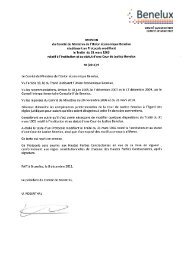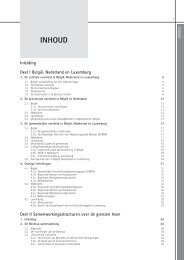The North Seas Countries' Offshore Grid Initiative - Initial ... - Benelux
The North Seas Countries' Offshore Grid Initiative - Initial ... - Benelux
The North Seas Countries' Offshore Grid Initiative - Initial ... - Benelux
Create successful ePaper yourself
Turn your PDF publications into a flip-book with our unique Google optimized e-Paper software.
are hosted by, and pass through, a different market node. <strong>The</strong> annual net export balance<br />
for each market node was calculated by subtracting gross imports from gross exports.<br />
By energy, Belgium and Great Britain are the largest importers in this scenario due to the<br />
assumption that coal is ahead of gas in the merit order and the high proportion of gasfired<br />
generators in their systems. Germany, France, the Netherlands, Norway and Sweden<br />
are large exporters. <strong>The</strong> region as a whole is exporting approximately 110 TWh towards<br />
its neighbouring countries outside the region, which is about 5% of the region’s annual<br />
demand Figure 4-4.<br />
Luxembourg, Denmark East and Belgium are the largest importers in terms of percentage<br />
of their own demand. <strong>The</strong> Netherlands is a large exporter in terms of percentage of its<br />
demand.<br />
Figure 4-3 Import/Export Balance in TWh by NSCOGI Country and for the Region as a Whole7 in the<br />
NSCOGI Reference Scenario for the year 2030 with grid 2020 capacities<br />
Overall the NSCOGI region is a net exporter, with about 110 TWh produced in the NSCOGI<br />
countries for export to meet demands outside the region. This represents an addition 5%<br />
production over the region’s own demand as shown in Figure 4-4. <strong>The</strong> figure also<br />
presents each country’s import/export position in relation to its own demand. France is by<br />
far the biggest exporter, but in terms of the size of its system, Netherlands is the greatest<br />
exporter. Similarly while Great Britain and Belgium import more energy than any other<br />
country, Denmark East and Luxembourg import the highest percentages of their demand<br />
from neighbouring countries. It should be noted that this does not suggest that they rely<br />
on other countries. For these countries the simulations show that the prices of<br />
neighbouring markets are lower making it more economic to import than to produce<br />
electricity with their more expensive national generators.<br />
7<br />
While the gross import, gross export and net export balances are provided for each market node,<br />
only the net export balance is provided for the NSCOGI region as a whole.<br />
Page 30 of 142










